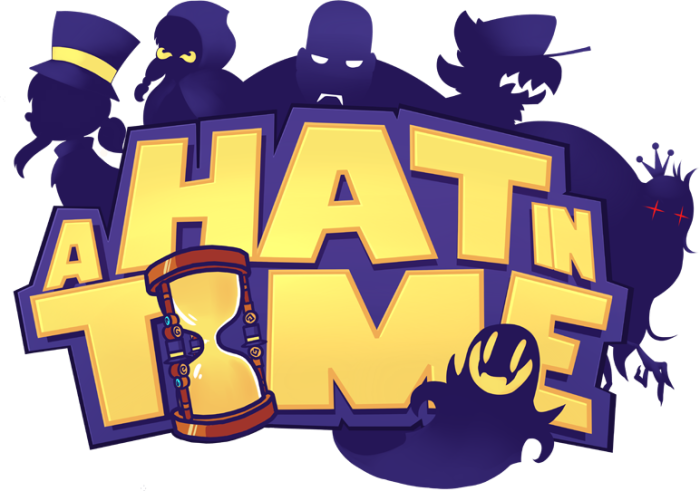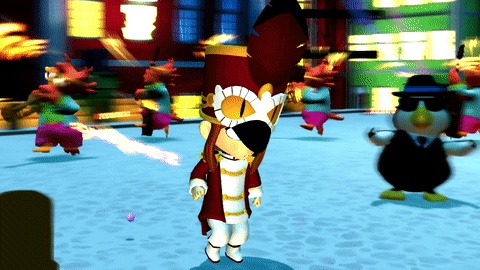
Travel back in time with me to 2013, before Mario found a new hat friend or lizards and bats decided to go on adventures together. Back when anything remotely nostalgic in gaming was almost guaranteed to meet it’s funding goal. Gears for Breakfast raised over $296,000- almost ten times the $30,000 asked for the production of A Hat in Time. Now almost four years later, A Hat in Time is ready to shine. Having high expectations from an audience has destroyed many a Kickstarter project, but A Hat in Time manages to feel modern while wearing a comfy blanket of nostalgia without being smothered by it.

A Hat in Time is the story of a young girl, referred to as Hat Kid, who is traveling towards her home. After a minor accident, all of her ship’s fuel, little hourglasses, fall out onto different worlds. Hat Kid begins her adventure to collect them to finally return home. However, others figure out that these hourglasses have powers, including the ability to effect time. Hat Kid’s story isn’t the focus here, it’s background dressing to give the player a reason for traveling to different places. What’s more important is the individual stories told amongst the worlds. Their stories are what defines all of the environment and most of the gameplay. Worlds, or Chapters, are made up of Acts that play out like episodes of a TV show for each chapter. For instance, Chapter 2 is a story about two competing movie production teams fighting to make their movie stand out above the others. Each Act has the player working with one team or the other to produce the films.
These Acts usually give the player access to almost everywhere in a world, but some Acts have sectioned off portions of the world, or in one case, the Acts are split between three different unique locations. This limiting of exploration isn’t the norm in these sorts of games these days, but it helps to make each environment stand out. Starting each Act in different areas allows players to see the world in a different orientations, possibly helping to spot a collectible not seen before. Some Acts have different lighting, suggesting the passage of time. A few Acts also have environment changes, forcing players to have to adapt their traversal lines, giving them another orientation to learn about the ins and outs of the stage as well as the game’s movement.

Speaking of movement, A Hat in Time nails platforming better than any of it’s nostalgic references ever dreamed to. Hat Kid runs and jumps with the best of them, but also features a dive move, which makes traversing large areas way easier. Mastering the dive is key to getting the most out of platforming and getting some of the more difficult collectibles. In some of the time rifts, specific levels made to focus on timing and platforming, advanced players can use the dive to get around harder sections. This also translates to the Acts proper, giving those players different routes to objectives if they are willing to go off the beaten path. It also features a hat system, giving Hat Kid different hats gives her different powers. An ice hat allows Hat Kid to use specially marked tiles to jump to far off locations, while a creepy mask brings objects from other dimensions into view. Hats affect traversal in different ways, and are unlocked by collecting yarn found across all of the stages. Because of this, players will have to return to older chapters after they have gained the use of certain hats if they wish to complete a chapter’s story or collect all of the hourglasses and find all of the time rifts. Thankfully, A Hat in Time mentions during Act selection if you do not currently have the right abilities to complete the Act.
Just looking at the different worlds, you can tell a lot of time and effort went into making sure they each felt unique to themselves, while also feeling unified in the game’s universe, and aiming for a style that you might have seen on something like the Gamecube. Everything is vibrant and cute. Even animations are adorable – when in idle, Hat Kid will pull out two dolls and make them kiss. Or when she is being chased in the dark, she has her hands out in front of her making sure she isn’t going to run into anything. A Hat in Time manages to balance this cuteness with times of intense platforming. I use intense not to make it sounds overly difficult, but players do have to pay attention to what they are doing. Thankfully the movement gives players great efficacy in Hat Kids movement. I never felt like I messed up the platforming because of the game, it was always my fault for not paying attention or being overly ambitious. My only complaint is occasionally rope lines you have to traverse seem to have different levels of magnetism to them. Some feel overly sticky, making it hard to transfer between two close together, while others seem to require near perfection to land on. This only rears its head two or three times, but enough to be noticeable. For the speed runners among us, the game has a few features to make things suited for that style of play. Including an on screen clock, and the option to automatically skip cut-scenes.

A Hat in Time finds itself released at an interesting time. Nintendo has thrown its favorite red hat wearing mascot out again to critical acclaim, but that shouldn’t intimidate Hat Kid. While Mario is attempting to soar to new heights, A Hat in Time tips its cap to all of your nostalgia for this type of game while still feeling modern. It plays like you hope Super Mario 64 or Banjo Kazooie would if you turned them on today, just without all of the janky controls and clunky mechanics. It’s perfect for all of those old school fans, while also being a perfect introduction to platformers for players that are curious but don’t want to go full retro.
A Hat in Time was reviewed using a PSN retail code provided by the developer. A Hat in Time is also available on Xbox One and PC


No Comments